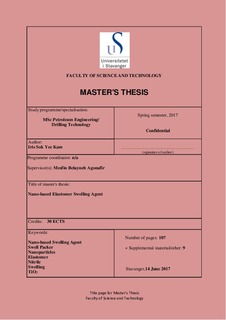| dc.contributor.advisor | Agonafir, Mesfin Belayneh | |
| dc.contributor.author | Kam, Iris Sok Yee | |
| dc.date.accessioned | 2017-11-01T10:21:51Z | |
| dc.date.available | 2017-11-01T10:21:51Z | |
| dc.date.issued | 2017-06 | |
| dc.identifier.uri | http://hdl.handle.net/11250/2463394 | |
| dc.description | Master's thesis in Petroleum engineering | nb_NO |
| dc.description.abstract | With multistage hydraulic fracturing and extended reach wells becoming increasingly common, the need for effective annular zonal isolation has become paramount. In such wells, swell packers are being preferred over traditional options such as mechanical packers and cementing. Significant cost savings due to reduction in rig time and all expenditures associated with cementing, perforating and coiled tubing operations have been a strong reason behind swell packers’ success. However, premature expansion of these packers along with a lack of precise control of the swelling behavior have continued to be disadvantages associated with this technology.
To tackle these limitations, a novel idea was conceptualized to develop a TiO2 nanoparticle-based trigger mechanism to activate swellable elastomers. These nano-based swelling agents (abbreviated as NSA) are designed to provide accurate control of when the downhole expansion of the swell packers is initiated, thereby, preventing problems associated with premature expansion.
Suitable nano-based swelling agents (NSA) were developed and tested with different elastomers to characterize their swelling performance. After six stages of experimentation, 4 systems were identified as the optimal combinations of elastomer and nano-based swelling agents (NSA). The extent of swelling volume and the rate of swelling were identified as key metrics in this narrowing down process. Additionally, performance of the systems under varying operational factors such as the wellbore fluid type, temperature and pH of the downhole environment were also important considerations.
The data gathered from all the experiments was then used to generate a predictive model to determine the performance for different NSA-rubber systems as a function of operating temperature and exposure time. The equations for the different systems generated was a variation of the power law form. In the final part of the thesis, a selection chart was developed to aid users in choosing the optimal nano-based swelling system depending on operational and budgetary constraints. | nb_NO |
| dc.language.iso | eng | nb_NO |
| dc.publisher | University of Stavanger, Norway | nb_NO |
| dc.relation.ispartofseries | Masteroppgave/UIS-TN-IPT/2017; | |
| dc.subject | petroleumsteknologi | nb_NO |
| dc.subject | petroleum engineering | nb_NO |
| dc.subject | boreteknologi | nb_NO |
| dc.subject | nano-based swelling agent | nb_NO |
| dc.subject | swell packer | nb_NO |
| dc.subject | nanoparticles | nb_NO |
| dc.subject | elastomer | nb_NO |
| dc.subject | nitrile | nb_NO |
| dc.subject | swelling | nb_NO |
| dc.subject | TiO2 | nb_NO |
| dc.title | Nano-based Elastomer Swelling Agent | nb_NO |
| dc.type | Master thesis | nb_NO |
| dc.subject.nsi | VDP::Technology: 500::Rock and petroleum disciplines: 510::Petroleum engineering: 512 | nb_NO |
